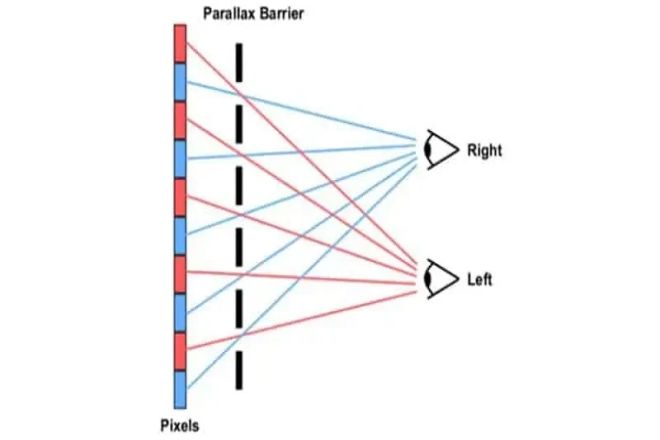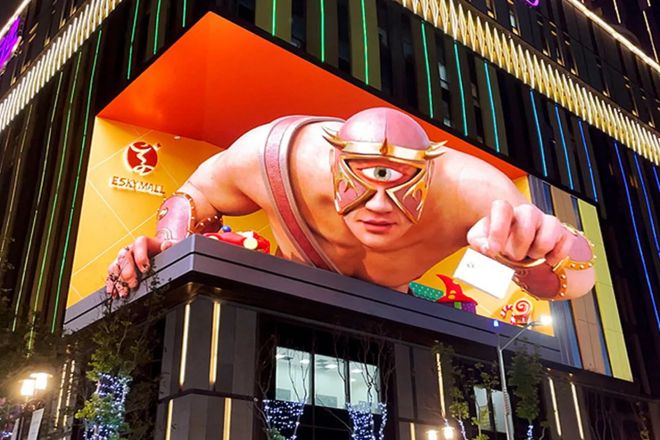Introduction

Comme Affichage LED se développe à ce jour, nous voyons souvent de nombreux rapports disant que « l'écran LED brise la 3D et entre dans l'ère 5D » et ainsi de suite, mais pourquoi avons-nous rarement vu des écrans LED 5D, 6D et autres dans nos vies ? Quelle est la différence entre eux et Écrans LED 3D?
Cet article va sélectionner un écran LED 5D dont on parle le plus et le comparer avec l'écran LED 3D que l'on voit souvent. Jetons un oeil.
1. Analyse conceptuelle de l'affichage LED 3D

En tant que représentant exceptionnel de la technologie d'affichage moderne, l'écran LED 3D combine intelligemment la haute luminosité, la longue durée de vie et les excellentes performances de couleur de la LED (diode électroluminescente) avec une technologie d'affichage stéréoscopique avancée pour offrir aux utilisateurs un festin visuel sans précédent.
Cet affichage innovant n’est pas seulement un support d’information mais aussi une œuvre d’art capable de stimuler les sens et de créer une expérience immersive.
Son principal atout réside dans sa capacité unique d'affichage d'images en trois dimensions, qui transcende les limites des écrans bidimensionnels traditionnels, permettant aux images de « sauter sur l'écran » et de présenter une riche sensation de profondeur et une large sensation d'espace. Derrière cette réussite se cache la combinaison parfaite d'une conception technique sophistiquée et de principes scientifiques visuels complexes.
Plus précisément, les écrans LED 3D tirent parti du phénomène de parallaxe naturel des yeux humains : en raison de la légère différence de position des yeux, il existe de subtiles différences dans les images vues par les yeux gauche et droit.
Ces informations différentes sont traitées dans le cerveau et forment finalement le monde tridimensionnel que nous percevons.
Pour obtenir un effet 3D à l'œil nu, les écrans LED 3D utilisent une variété de moyens techniques. Tout d'abord, grâce à la disposition matricielle de points LED de haute précision, il est garanti que chaque pixel peut être contrôlé avec précision pour présenter une image délicate et superposée.
Deuxièmement, grâce à des algorithmes de traitement d'image avancés, l'image d'origine est segmentée, ajustée et optimisée pour générer deux images légèrement différentes adaptées respectivement à l'œil gauche et à l'œil droit. Les deux images sont astucieusement décalées sur l'écran d'affichage.
Lorsque le public se tient dans une position de visionnement spécifique, les yeux gauche et droit reçoivent respectivement les informations d'image correspondantes, synthétisant ainsi un effet visuel tridimensionnel dans le cerveau.
De plus, afin d'améliorer encore l'expérience de visionnage, l'écran LED 3D utilise également une technologie d'affichage grand angle et une conception à taux de rafraîchissement élevé. La technologie d'affichage grand angle garantit que le public peut obtenir un bon effet tridimensionnel sous différents angles, tandis que le taux de rafraîchissement élevé réduit efficacement les bavures et le flou de l'image, rendant l'image plus fluide et plus naturelle.
Analyse du concept d'affichage LED 2.5D
En tant que nouvelle étoile brillante et nouvelle étape dans le domaine de la technologie d'affichage, le nom d'écran LED 5D n'est pas un simple empilement de dimensions d'espace physique ou une extension à cinq dimensions au sens littéral, mais une expression créative qui reflète profondément l'intégration de l'innovation technologique et de l'expérience sensorielle.
Il s'agit d'une forme d'affichage multimédia révolutionnaire qui vise à amener le public dans un environnement immersif au-delà de la réalité d'une manière sans précédent, réalisant une interaction sensorielle multidimensionnelle et profonde et une expérience émotionnelle.
L'innovation technologique est la force motrice principale derrière la création d'un écran LED 5D. Cet écran intègre la technologie d'affichage, la technologie audio et la technologie de retour tactile les plus avancées et peut même inclure des technologies de pointe telles que la libération d'odeurs et la simulation du goût, tissant ensemble un réseau d'expérience immersive multisensorielle en pleine dimension.
En termes de vision, l'écran LED haute définition et délicat combiné à une technologie de rendu 3D avancée présente une image tridimensionnelle choquante, donnant au public l'impression d'être dans l'image ; en termes d'audition, la combinaison d'effets sonores surround et d'une technologie audio de positionnement précis crée un environnement sonore réaliste et améliore l'immersion de la scène.
En termes de toucher, grâce à des dispositifs de rétroaction physique tels que des sièges vibrants et des dispositifs à effet de vent, le public peut ressentir l'action et l'atmosphère de l'image et obtenir une expérience synchrone du corps et de la vision.
De plus, certains écrans LED 5D haut de gamme peuvent également introduire un système de libération d'odeurs pour libérer les odeurs correspondantes en fonction des changements de scène et essayer de simuler l'expérience gustative par des moyens spéciaux, de sorte que l'expérience sensorielle du public soit d'une richesse et d'une réalité sans précédent.
Cette expérience immersive complète améliore non seulement considérablement le sentiment de participation et de substitution du public, mais rend également la transmission d’informations et la communication émotionnelle plus directes et plus profondes.
Dans de nombreux domaines, tels que la publicité, le divertissement, l’éducation et les expositions, les écrans LED 5D ont montré un grand potentiel d’application et une grande valeur.
Par exemple, dans le publicité Dans le domaine du divertissement, il peut attirer l'attention des consommateurs d'une manière plus vivante et intéressante, améliorer la mémoire de la marque et l'intention d'achat ; dans l'industrie du divertissement, les cinémas 5D, les salles de jeux et d'autres lieux utilisent des écrans d'affichage LED 5D pour créer des espaces d'expérience immersifs, apportant un plaisir de divertissement sans précédent au public.
Dans le domaine de éducation et expositionLes écrans d'affichage LED 5D peuvent simuler des scènes réelles et restaurer des moments historiques, rendant le processus d'apprentissage et de visite plus intuitif, intéressant et productif.
3. Comparaison technique entre les écrans LED 3D et 5D

Il existe des différences techniques importantes entre les écrans d’affichage LED 3D et 5D, qui se reflètent principalement dans les effets visuels, la mise en œuvre technique, les scénarios d’application et l’expérience utilisateur.
1). Effet visuel
- Écran d'affichage LED 3D :
Principalement grâce à la technologie d'imagerie visuelle stéréoscopique, le public peut regarder des images stéréoscopiques avec un sens de la profondeur et de l'espace sans porter de lunettes spéciales.
Cette technologie projette des images différentes vers l'œil gauche et l'œil droit, respectivement, en utilisant la technologie spatiale. résolution capacité de l’œil humain et du traitement complet des nerfs cérébraux à présenter un effet visuel tridimensionnel.
Les écrans d'affichage LED 3D présentent également des performances élevées en termes de clarté, de contraste et de saturation des couleurs, ce qui peut apporter une expérience visuelle plus réaliste et plus choquante au public.
- Écran d'affichage LED 5D :
Sur la base de la 3D, il intègre en outre une technologie d'expérience multisensorielle, notamment l'ouïe, le toucher, l'odorat, le goût, etc., pour créer une expérience immersive et pleine dimension.
Bien que le terme « 5D » ne soit pas précis en termes de dimensions physiques, il représente le progrès de la technologie en offrant des expériences sensorielles plus riches et plus complexes.
Les écrans d'affichage LED 5D ont non seulement d'excellents effets visuels, mais peuvent également donner au public l'impression d'être dans la scène d'un film, d'un jeu ou d'une exposition grâce à divers moyens tels que le son, les vibrations, l'odeur, etc.
2). Réalisation technique
- Écran d'affichage LED 3D :
L'écran LED 3D repose principalement sur la technologie d'imagerie stéréoscopique et la technologie de matrice de points LED haute résolution. Ces technologies permettent aux écrans LED 3D de présenter des images claires, délicates et tridimensionnelles.
Dans le même temps, afin d'améliorer l'expérience visuelle, les écrans d'affichage LED 3D peuvent également utiliser une technologie d'angle de vision large et une technologie de réglage de la luminosité/contraste pour garantir que le public puisse obtenir de bons effets visuels sous différents angles et conditions d'éclairage.
- Écran d'affichage LED 5D :
La réalisation technique est plus complexe et plus diversifiée. En plus de la technologie d'imagerie stéréoscopique et de la technologie de matrice de points LED haute résolution, les écrans d'affichage LED 5D doivent également combiner plusieurs dispositifs et technologies tels que des systèmes sonores, des dispositifs de vibration et des dispositifs de libération d'odeurs pour réaliser l'intégration d'une expérience multisensorielle.
De plus, afin d'obtenir une expérience interactive plus précise et personnalisée, les écrans d'affichage LED 5D peuvent également adopter des technologies avancées telles que la technologie d'interaction dynamique, la technologie de perception environnementale et la technologie de réglage adaptatif.
3). Scénarios d'application
Les écrans d'affichage LED 3D sont largement utilisés dans le commerce publicité, des expositions, cinémas et autres domaines. Dans la publicité commerciale, les écrans d'affichage LED 3D peuvent attirer l'attention des clients et améliorer l'image de marque et les ventes.
Dans les expositions, les écrans d'affichage LED 3D peuvent afficher de manière vivante les objets exposés et améliorer le sentiment de participation et les points de mémoire du public ; dans les cinémas, les écrans d'affichage LED 3D peuvent apporter au public une expérience de visionnage plus réaliste et plus choquante.
Les écrans d'affichage LED 5D sont de plus en plus utilisés dans les parcs à thème, la science et la technologie musées, musées et autres lieux qui nécessitent une grande interactivité et une immersion.
Dans ces lieux, les écrans d'affichage LED 5D peuvent combiner d'autres équipements et technologies pour créer une scène d'expérience interactive riche et diversifiée, donnant au public l'impression d'être dans un monde plein de fantaisie et de surprises.
4). Expérience utilisateur
- Affichage LED 3D :
En offrant des effets visuels stéréoscopiques et un affichage d'image de haute qualité, il offre au public une expérience visuelle plus réaliste et plus choquante. Cependant, cette expérience se limite principalement à l'aspect visuel et ne fait pas appel aux autres sens.
- Affichage LED 5D :
L’intégration d’une technologie d’expérience multisensorielle offre au public une expérience immersive plus complète et plus approfondie.
Le public peut non seulement voir les images stéréoscopiques, mais également entendre des effets sonores réalistes, ressentir le toucher vibratoire et sentir des odeurs spécifiques.
Cette expérience sensorielle complète permet au public de participer plus profondément à la scène et de vivre une expérience émotionnelle plus riche et plus profonde.
En fait, les produits d'affichage LED sont les mêmes, mais il y a quelques ajustements dans l'emplacement d'installation et la forme.
La raison principale est que les sources vidéo 3D et 5D sont très différentes, et la 5D ajoute d’autres expériences sensorielles sur la base d’effets visuels 3D.
La 5D est généralement utilisée pour intérieur Les projets de divertissement, les films ou les expositions thématiques et les écrans 3DLED sont essentiellement affichés à l'extérieur et à l'intérieur.
4. En tant qu'investisseur, quel écran LED est le plus avantageux, 3D ou 5D ?
Pour les investisseurs, les écrans LED 3D et les écrans LED 5D présentent chacun leurs propres avantages et scénarios d'application, il est donc impossible de juger simplement lequel est le plus avantageux. Voici une analyse détaillée des deux écrans :
1). Affichage LED 3D
1.1). Avantages :
Haute exposition : les écrans LED 3D sont généralement installés dans des emplacements géographiques à fort trafic et à forte exposition, tels que les centres commerciaux, les panneaux d'affichage extérieurs, etc., ce qui peut attirer l'attention d'un grand nombre de téléspectateurs et améliorer l'effet de communication de la publicité.
Recettes publicitaires : En diffusant du contenu publicitaire, les investisseurs peuvent obtenir des frais publicitaires comme source de revenus. Dans les zones à fort trafic, les recettes publicitaires sont souvent très importantes.
Technologie mature : la technologie d'affichage LED 3D est relativement mature, il existe de nombreux cas de réussite et une chaîne d'approvisionnement stable sur le marché, et il est relativement facile pour les investisseurs de choisir et d'exploiter.
1.2). Scénarios applicables :
Panneaux d'affichage extérieurs, Centre commercial grands écrans, Stades, concerts et autres événements de grande envergure
2). Affichage LED 5D
2.1). Avantages :
Expérience immersive : un écran LED 5D peut offrir au public une expérience de visionnement immersive grâce à des effets spéciaux tels que des vibrations, des projections d'eau, du vent, etc., tout en diffusant le film, améliorant ainsi le divertissement et l'interactivité.
Forte valeur ajoutée : En raison de l'expérience immersive unique, les écrans d'affichage LED 5D attirent souvent plus de touristes et de publics, entraînant ainsi des frais de billets ou d'expérience plus élevés.
Forte innovation : les écrans d'affichage LED 5D représentent la direction innovante de la technologie d'affichage et sont très attractifs pour les investisseurs qui recherchent des expériences nouvelles et uniques.
2.2). Scénarios applicables :
Parcs d'attractions intérieurs, salles de cinéma. Lieux éducatifs et de divertissement tels que musées des sciences et de la technologie et musées
3). Conseils en investissement
Lors du choix des écrans d’affichage LED 3D ou 5D, les investisseurs doivent tenir compte de leurs objectifs d’investissement, de leur solidité financière, de leur positionnement sur le marché et des besoins du public cible.
Si les investisseurs souhaitent obtenir des revenus publicitaires rapidement et réduire les risques opérationnels, les écrans d’affichage LED 3D peuvent être un choix plus sûr.
Si les investisseurs recherchent l’innovation et une forte valeur ajoutée et sont prêts à supporter certains risques de marché et coûts d’exploitation, alors les écrans d’affichage LED 5D peuvent apporter de meilleurs rendements.
En bref, les écrans LED 3D et les écrans LED 5D ont chacun leurs avantages et leurs scénarios d'application spécifiques. Les investisseurs doivent faire des choix judicieux en fonction de leur situation personnelle.
Conclusion
Avec la fin de notre exploration commune, je pense que vous comprenez mieux la différence entre les écrans LED 3D et les écrans LED 5D. Du simple choc visuel au festin sensoriel à grande échelle, le progrès technologique a non seulement élargi nos horizons, mais a également enrichi notre expérience de vie.
Enfin, si vous souhaitez en savoir plus sur les écrans LED, veuillez nous contacter.
